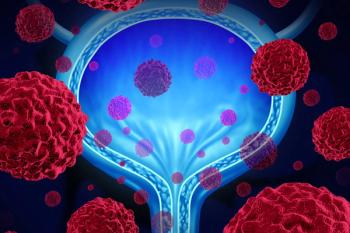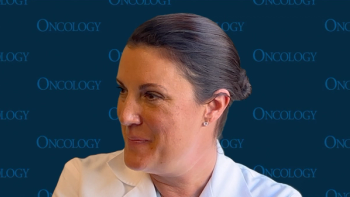
Atezolizumab Plus Chemo Is Safe, Efficacious in Broader ES-SCLC Population
The median overall survival with atezolizumab plus carboplatin and etoposide was 10.6 months in patients with extensive-stage small cell lung cancer.
Atezolizumab (Tecentriq) in combination with carboplatin and etoposide demonstrated safety and efficacy findings consistent with what has been seen in previous studies, such as the phase 3 IMpower133 trial (NCT02763579), in a patient population with extensive-stage small cell lung cancer (ES-SCLC) similar to the real world, according to end-of-study results from the phase 3b MAURIS trial (NCT04028050) published in Clinical Lung Cancer.
The median overall survival (OS) was 10.6 months (95% CI, 9.8-13.7), with a 1-year OS rate of 45.5%, a 1.5-year OS rate of 31.0%, a 2-year OS rate of 17.1%, and a 3-year OS rate of 14.5%. The median progression-free survival (PFS) was 5.5 months (95% CI, 5.3-5.7).
In patients who received less than 4 cycles of treatment, the median OS was 2.7 months (95% CI, 1.0-7.6) and the median PFS was 1.8 months (95% CI, 1.0-3.9). In those who received 4 cycles of therapy, the median OS was 10.4 months (95% CI, 8.6-14.2), with a 1-year OS rate of 45.2%, a 1.5-year OS rate of 29.3%, a 2-year OS rate of 14.6%, and a 3-year OS rate of 12.5%; the median PFS was 4.5 months (95% CI, 4.1-5.5). In those who received 5 or 6 cycles of therapy, the median OS was 13.7 months (95% CI, 10.7-17.6), with a 1-year OS rate of 54.7%, a 1.5-year OS rate of 37.3%, a 2-year OS rate of 22.0%, and a 3-year OS rate of 18.5%; the median PFS was 5.8 months (95% CI, 5.5-6.4).
In the 14 patients treated with thoracic radiotherapy, the median OS was 19.3 months (95% CI, 13.7-not reached), and in the 10 patients who had at least 1 grade 3 or 5 immune-mediated treatment-emergent adverse effect (TEAE), the median OS was 13.1 months (95% CI, 0.9-27.1).
In all patients, the overall response rate (ORR) was 72.3%, with 6 (3.9%) complete responses, 106 (64.8%) partial responses, 25 (16.1%) instances of stable disease, and 8 (5.2%) instances of progressive disease. The median duration of response (DOR) was 4.2 months (95% CI, 4.1-4.5).
“The results of this analysis at the end of the MAURIS study show that safety and efficacy of atezolizumab plus carboplatin and etoposide in the frontline treatment of ES-SCLC in a population more similar to real-life patients are consistent with findings from the IMpower133 phase 3 trial,” wrote lead study author Floriana Morgillo, of the Department of Precision Medicine of Medical Oncology and Hematology at University of Campania “Luigi Vanvitelli” in Naples, Italy, and coauthors in the paper.
MAURIS was a multicenter, open-label, single-arm trial that enrolled a total of 155 patients with ES-SCLC. In the induction phase, treatment consisted of 1200 mg of atezolizumab plus area under the curve 5 mg/mL per minute of carboplatin and 100 mg/m2 body surface area of etoposide on days 1 to 3 of each cycle; treatment was received in 21-day cycles for 4 to 6 cycles, depending on the investigator’s discretion. In the maintenance phase, patients received atezolizumab every 3 weeks until disease progression, unacceptable toxicity, or clinical deterioration.
Eligible patients had histologically or cytologically confirmed ES-SCLC, measurable disease per RECIST v1.1, an ECOG performance status of 0 to 2, no prior receipt of systemic treatment for ES-SCLC, and adequate hematologic and end-organ functions.
The primary trial end points were the incidence of serious AEs (SAEs) and the incidence of serious and nonserious immune-mediated AEs. The secondary end points were the incidence of AEs of special interest, incidence of AEs associated with drug-induced liver injury, OS, PFS, ORR, and DOR.
Univariate and multivariate analyses found that increased mortality was associated with the presence of liver metastases at baseline (HR, 1.68; 95% CI, 1.17-2.41) and a low number of induction cycles (HR, 8.08; 95% CI, 4.28-15.23). The occurrence of immune-mediated SAEs during the follow-up period was inversely related to the risk of death (HR, 0.36; 95% CI, 0.13-0.97) in the multivariate model.
Regarding safety, at least 1 TEAE occurred in 90.3% of patients in the induction phase, 66.7% of the maintenance phase, and 96.8% of patients in the overall trial period. TEAEs led to death in 3.9% of patients, with 1 case of death due to pneumonia being treatment related.
SAEs occurred in 38.3% and treatment-related SAEs in 21.4%; at least 1 immune-mediated TEAE occurred in 14.9% in the induction phase, 20.8% in the maintenance phase, and 26.6% in the overall trial period.
Reference
Morgillo F, Del Signore E, Bria E, et al. The Italian Mauris phase IIIb trial of atezolizumab plus carboplatin and etoposide for patients with newly diagnosed extensive-stage small cell lung cancer: three-year end-of-study results. Clin Lung Cancer. Published online July 9, 2025. doi:10.1016/j.cllc.2025.07.003
Newsletter
Stay up to date on recent advances in the multidisciplinary approach to cancer.


















































































